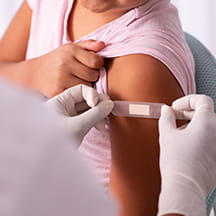Eighteen years ago, Nationwide Children’s Hospital identified a public health issue in their communities. They called it the “neighborhood effect syndrome,” characterized by symptoms of extreme poverty, including blight, housing insecurity, racial segregation, environmental toxins, and more.
“Our providers were frequently encountering challenges in caring for children from affected neighborhoods, and these children often experienced poorer outcomes compared to peers in unaffected neighborhoods,” said Carla D. Fountaine, MHA, director of community relations at the hospital.
In response, Nationwide Children’s leaders and community partners chartered a novel approach at the time: treating the neighborhood as a patient. In collaboration with residents, government entities, and social services agencies, the hospital started developing solutions for the neighborhood effect syndrome through its Healthy Neighborhoods Healthy Families (HNHF) initiative.
Since 2008, Healthy Neighborhoods Healthy Families has provided affordable housing, education, health and wellness, community enrichment, and economic development through a variety of programs and pathways.
Most recently, Healthy Neighborhoods Healthy Families is promoting economic development through a free mentoring program for adults designed to promote financial self-sufficiency. Many people in Healthy Neighborhoods Healthy Families ZIP codes live in financial service deserts, are victims of predatory lending practices, and experience financial stressors that hinder their economic stability.
“Creating a healthy neighborhood includes helping families find a path to financial success,” Fountaine said. “When a family experiences financial challenges, it can be hard to break the cycle. We want to help people understand their obstacles, help identify solutions, and connect them with resources that can help.”
Based on the Economic Mobility Pathways (EMPath) model, My Bridge 2 Success supports participants in creating and achieving personal and long-term goals that relate to their family life, finances, education, and career. Participants work with mentors to create goals and a plan to achieve financial independence.
“People in the program have been able to get reliable transportation and housing, pay off debt, and save for a down payment on a home,” said Sam Ricks, economic opportunity project manager at Healthy Neighborhoods Healthy Families.
My Bridge 2 Success
Participants in My Bridge 2 Success meet monthly with a mentor for a year to receive guidance in goal setting, problem solving, and navigating barriers.
“A big component of this program is helping our participants think through their long-term goals,” Ricks said. “And then what makes sense to start with today and what to work on this month.”
Mentors use a tool called Bridge to Self-Sufficiency to guide goal-setting and measure progress at the beginning, at six months, and at a year.
Some goals include:
- Open a savings account.
- Make a downpayment for a new vehicle.
- Purchase a house.
- Secure a degree.
- Work toward a promotion.
- Focus on increasing mental and physical health.
Mentors, made up of economic development and community health staff, are trained in motivational interviewing, cultural competency, financial literacy, and family stability, though they approach their mentorship less as a coach and more as a counselor.
“The program is really participant-led,” Ricks said. “A lot of the folks that we're working with understand better than anybody what they're going through. Our job isn't to tell them, you shouldn't be doing this or doing that. We seek to understand what they're going through and what they really need.”
Savings match
In addition to mentoring, the program offers a savings match to participants up to $5,000. Mentors work with them to set a specific savings goal, and once the participants deposit funds in their account, they receive a matching amount from the hospital.
“We know people need some support with these basic financial life tasks, and we want to remove as many obstacles for them as we can,” Ricks said
One thing the team has learned is that many people in the program who desire the savings match aren’t in a place to start saving. “We had to take a few steps back to look at budgeting and how to cut expenses and reduce debt so they can actually start,” Ricks said. “In some instances, it led to conversations about applying for higher-earning jobs.”
Enrollment and eligibility
A few years into the program, Ricks and his team adjusted the eligibility criteria.
“Our program is designed to help support low-income families, so we wanted to make sure we were capturing our target demographic,” Ricks said.
There are four criteria:
- Reside in a Healthy Neighborhood Healthy Families target ZIP code.
- Employed part-time or full-time consistently for 90 days or more.
- Total household income at or below 300% of the Federal Poverty Level.
- 18 years or older.
Those who are unemployed first get referred to a local workforce development program, which helps them find a job before they join the program. “We understand some people are searching for jobs and looking to gain income, and we still want to work with them,” Ricks said.
The program currently has capacity for 30 participants, but the team is looking to recruit more mentors to accommodate the ever-growing list of applicants. Even as the numbers increase, the program will always stay personal.
“What's great about doing this work and being one of our mentors is not looking only at numbers and data but really at individuals,” Ricks said. “My favorite part of the program is being able to work with individuals and seeing them grow over the course of the year.”
Ricks and Fountaine's presentation, “Creating Employment Pathways and Promoting Economic Stability,” was an educational session at Children's Hospital Association’s 2024 Transforming Quality Conference.


